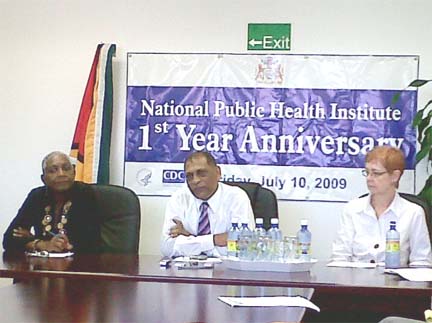Health Minister, Dr Leslie Ramsammy says laboratory testing for the H1N1 virus here could begin shortly as a US team has arrived to facilitate training. He said the initiative would boost both the national and regional capacity for testing.

International laboratory specialist Dr Lucy Perrone of the US Centers for Disease Control and Prevention (CDC) is leading a team which will conduct a one-week training programme on diagnosis of novel influenza A, H1N1 virus by the real time reverse transcription- polymerase chain reaction RRT- PCR. The team also includes Deputy Directors of CDC Guyana, Wrenn Slocum and Leslie Edwards.
The Caribbean Epidemiology Centre (CAREC) has confirmed 1,435 cases of the H1N1 within the region since it first started testing for the virus in the region last year, 29 of the cases are from Guyana. Ramsammy told reporters yesterday that the CAREC confirmations are inclusive of several countries outside the Caricom member states. He said the number of specimens tested at CAREC is substantial, noting that on average 30 per cent of specimens sent for testing returned positive. In Guyana it has been around 20 percent.
Ramsammy said the region recorded 19 deaths in 6 countries which include Jamaica, Trinidad and Tobago, Barbados, Suriname, St Kitts and St. Lucia. He reiterated that Guyana has not had any deaths “as yet”. According to him, for 2009 the region has reported almost 400,000 cases of influenza like illnesses and about 50,000 came from Guyana. He said acute respiratory infections have been a major problem in the Caribbean and he emphasized that this reflects the more serious cases.
The minister maintained that CAREC has limited capacity for testing in the region as evident by the stipulation that only six specimens at any one time are accepted. He said Guyana has capacity for PRC technology and is now moving to facilitate the testing.
Health officials at the National Public Health lab; officials at the Georgetown Public Hospital and a few others would be trained in using real-time PCR technology, but specifically in testing for the virus.
By boosting capacity here, Ramsammy said, Guyana will also boost capacity in the region in addition to improving its algorithm for testing to have results on time. He said they are hoping to receive results in a timelier basis. The testing though be centralized in the city will be available to hospitals across the country including those in the private sector.
Ramsammy said doctors will not be sending people to the lab, but would send specimens to the lab.
The public health sector will offer free testing, but the private sector is expected to access the service at a cost. Ramsammy said that if doctors in the private sector follow the algorithm and test as recommended they might be able to access the service free, but if “they decide that all and sundry regardless of the recommendations are to be tested we will not be able to [offer] the service free.” He said it is important to keep things under control.
Commenting on the delayed shipment of H1N1 vaccines here Ramsammy said around 75,000 doses are likely to arrive shortly. He said this is below what was initially expected, but stressed that the national vaccination plan never catered for every citizen.
He reiterated that the sector had identified priority groups including some 90,000 children under five years old; around 5,000 healthcare frontline workers and about 50,000 persons living with other conditions for which co-morbidity for H1N1 would be fatal.
In terms of the capacity for treatment, Ramsammy said the country’s treatment plan had been in place during the initial stages of the flu virus. He said the Tamiflu vaccines had been in place early, noting that PAHO had made a contribution to the local stock level. He said the local production of Tamiflu is also available. Further, he added that the country remains at risk because there is no intention to close the borders.
The US team was expected shortly after Guyana had acquired the PRC equipment to test for H1N1 back in October 2009. Ramsammy told Stabroek News last year that when they are satisfied the testing in Guyana is of a high quality they will begin to do routine testing in Guyana and that results would be available in “over a day or two”.
